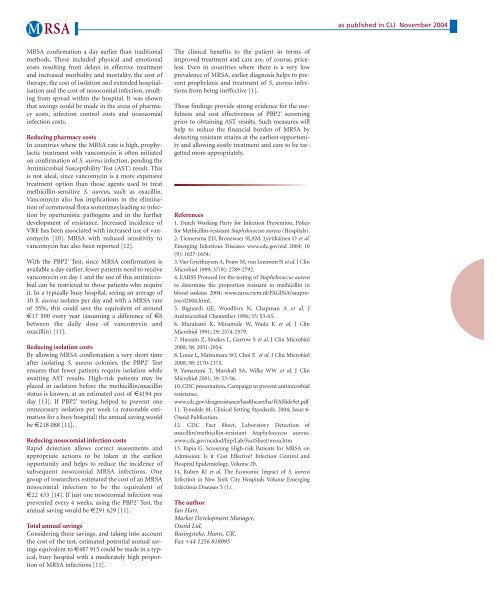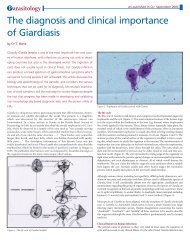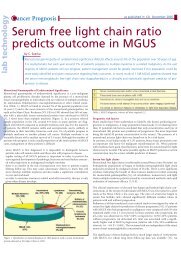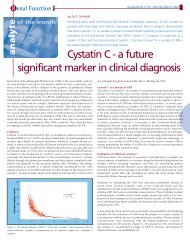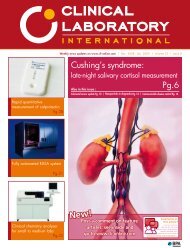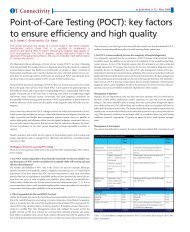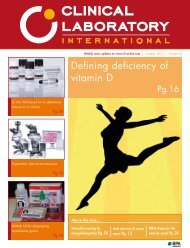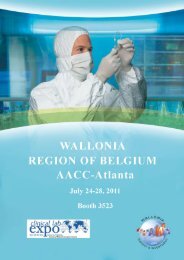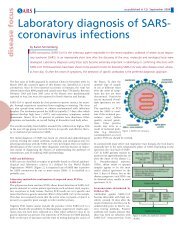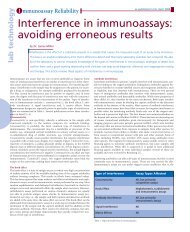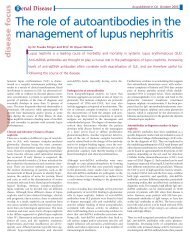A test for the early detection of MRSA: clinical benefits and financial ...
A test for the early detection of MRSA: clinical benefits and financial ...
A test for the early detection of MRSA: clinical benefits and financial ...
You also want an ePaper? Increase the reach of your titles
YUMPU automatically turns print PDFs into web optimized ePapers that Google loves.
M RSA<br />
as published in CLI November 2004<br />
<strong>MRSA</strong> confirmation a day earlier than traditional<br />
methods. These included physical <strong>and</strong> emotional<br />
costs resulting from delays in effective treatment<br />
<strong>and</strong> increased morbidity <strong>and</strong> mortality, <strong>the</strong> cost <strong>of</strong><br />
<strong>the</strong>rapy, <strong>the</strong> cost <strong>of</strong> isolation <strong>and</strong> extended hospitalisation<br />
<strong>and</strong> <strong>the</strong> cost <strong>of</strong> nosocomial infection, resulting<br />
from spread within <strong>the</strong> hospital. It was shown<br />
that savings could be made in <strong>the</strong> areas <strong>of</strong> pharmacy<br />
costs, infection control costs <strong>and</strong> nosocomial<br />
infection costs.<br />
Reducing pharmacy costs<br />
In countries where <strong>the</strong> <strong>MRSA</strong> rate is high, prophylactic<br />
treatment with vancomycin is <strong>of</strong>ten initiated<br />
on confirmation <strong>of</strong> S. aureus infection, pending <strong>the</strong><br />
Antimicrobial Susceptibility Test (AST) result. This<br />
is not ideal, since vancomycin is a more expensive<br />
treatment option than those agents used to treat<br />
methicillin-sensitive S. aureus, such as oxacillin.<br />
Vancomycin also has implications in <strong>the</strong> elimination<br />
<strong>of</strong> commensal flora sometimes leading to infection<br />
by opertunistic pathogens <strong>and</strong> in <strong>the</strong> fur<strong>the</strong>r<br />
development <strong>of</strong> resistance. Increased incidence <strong>of</strong><br />
VRE has been associated with increased use <strong>of</strong> vancomycin<br />
[10]. <strong>MRSA</strong> with reduced sensitivity to<br />
vancomycin has also been reported [12].<br />
With <strong>the</strong> PBP2' Test, since <strong>MRSA</strong> confirmation is<br />
available a day earlier, fewer patients need to receive<br />
vancomycin on day 1 <strong>and</strong> <strong>the</strong> use <strong>of</strong> this antimicrobial<br />
can be restricted to those patients who require<br />
it. In a typically busy hospital, seeing an average <strong>of</strong><br />
10 S. aureus isolates per day <strong>and</strong> with a <strong>MRSA</strong> rate<br />
<strong>of</strong> 35%, this could save <strong>the</strong> equivalent <strong>of</strong> around<br />
€17 500 every year (assuming a difference <strong>of</strong> €8<br />
between <strong>the</strong> daily dose <strong>of</strong> vancomycin <strong>and</strong><br />
oxacillin) [11].<br />
Reducing isolation costs<br />
By allowing <strong>MRSA</strong> confirmation a very short time<br />
after isolating S. aureus colonies, <strong>the</strong> PBP2' Test<br />
ensures that fewer patients require isolation while<br />
awaiting AST results. High-risk patients may be<br />
placed in isolation be<strong>for</strong>e <strong>the</strong> methicillin/oxacillin<br />
status is known, at an estimated cost <strong>of</strong> €4194 per<br />
day [13]. If PBP2' <strong>test</strong>ing helped to prevent one<br />
unnecessary isolation per week (a reasonable estimation<br />
<strong>for</strong> a busy hospital) <strong>the</strong> annual saving would<br />
be €218 088 [11].<br />
Reducing nosocomial infection costs<br />
Rapid <strong>detection</strong> allows correct assessments <strong>and</strong><br />
appropriate actions to be taken at <strong>the</strong> earliest<br />
opportunity <strong>and</strong> helps to reduce <strong>the</strong> incidence <strong>of</strong><br />
subsequent nosocomial <strong>MRSA</strong> infections. One<br />
group <strong>of</strong> researchers estimated <strong>the</strong> cost <strong>of</strong> an <strong>MRSA</strong><br />
nosocomial infection to be <strong>the</strong> equivalent <strong>of</strong><br />
€22 433 [14]. If just one nosocomial infection was<br />
prevented every 4 weeks, using <strong>the</strong> PBP2' Test, <strong>the</strong><br />
annual saving would be €291 629 [11].<br />
Total annual savings<br />
Considering <strong>the</strong>se savings, <strong>and</strong> taking into account<br />
<strong>the</strong> cost <strong>of</strong> <strong>the</strong> <strong>test</strong>, estimated potential annual savings<br />
equivalent to €487 915 could be made in a typical,<br />
busy hospital with a moderately high proportion<br />
<strong>of</strong> <strong>MRSA</strong> infections [11].<br />
The <strong>clinical</strong> <strong>benefits</strong> to <strong>the</strong> patient in terms <strong>of</strong><br />
improved treatment <strong>and</strong> care are, <strong>of</strong> course, priceless.<br />
Even in countries where <strong>the</strong>re is a very low<br />
prevalence <strong>of</strong> <strong>MRSA</strong>, earlier diagnosis helps to prevent<br />
prophylaxis <strong>and</strong> treatment <strong>of</strong> S. aureus infections<br />
from being ineffective [1].<br />
These findings provide strong evidence <strong>for</strong> <strong>the</strong> usefulness<br />
<strong>and</strong> cost effectiveness <strong>of</strong> PBP2' screening<br />
prior to obtaining AST results. Such measures will<br />
help to reduce <strong>the</strong> <strong>financial</strong> burden <strong>of</strong> <strong>MRSA</strong> by<br />
detecting resistant strains at <strong>the</strong> earliest opportunity<br />
<strong>and</strong> allowing costly treatment <strong>and</strong> care to be targetted<br />
more appropriately.<br />
References<br />
1. Dutch Working Party <strong>for</strong> Infection Prevention, Policy<br />
<strong>for</strong> Methicillin-resistant Staphylococcus aureus (Hospitals).<br />
2. Tiemersma ED, Bronzwaer SLAM, Lyytikäinen O et al.<br />
Emerging Infectious Diseases www.cdc.gov/eid 2004; 10<br />
(9): 1627-1634.<br />
3. Van Griethuysen A, Pouw M, van Leeuwen N et al. J Clin<br />
Microbiol 1999; 37(9): 2789-2792.<br />
4. EARSS Protocol <strong>for</strong> <strong>the</strong> <strong>test</strong>ing <strong>of</strong> Staphylococcus aureus<br />
to determine <strong>the</strong> proportion resistant to methicillin in<br />
blood isolates 2004; www.earss.rivm.nl/PAGINA/sauprotocol2004.html.<br />
5. Bignardi GE, Wood<strong>for</strong>s N, Chapman A et al. J<br />
Antimicrobiol Chemo<strong>the</strong>r 1996; 35: 53-63.<br />
6. Murakami K, Minamide W, Wada K et al. J Clin<br />
Microbiol 1991; 29: 2574-2579.<br />
7. Hussain Z, Stoakes L, Garrow S et al. J Clin Microbiol<br />
2000; 38: 2051-2054.<br />
8. Louie L, Matsumara SO, Choi E et al. J Clin Microbiol<br />
2000; 38: 2170-2173.<br />
9. Yamazumi T, Marshall SA, Wilke WW et al. J Clin<br />
Microbiol 2001; 39: 53-56.<br />
10. CDC presentation, Campaign to prevent antimicrobial<br />
resistance,<br />
www.cdc.gov/drugresistance/healthcare/ha/HASlideSet.pdf<br />
11. Tynedale M. Clinical Setting St<strong>and</strong>ards. 2004; Issue 6:<br />
Oxoid Publication.<br />
12. CDC Fact Sheet. Laboratory Detection <strong>of</strong><br />
oxacillin/methicillin-resistant Staphylococcus aureus.<br />
www.cdc.gov/ncidod/hip/Lab/FactSheet/mrsa.htm<br />
13. Papia G. Screening High-risk Patients <strong>for</strong> <strong>MRSA</strong> on<br />
Admission: Is it Cost Effective Infection Control <strong>and</strong><br />
Hospital Epidemiology. Volume 20.<br />
14. Ruben RJ et al. The Economic Impact <strong>of</strong> S. aureus<br />
Infection in New York City Hospitals Volume Emerging<br />
Infectious Diseases 5 (1).<br />
The author<br />
Ian Hart,<br />
Market Development Manager,<br />
Oxoid Ltd,<br />
Basingstoke, Hants, UK,<br />
Fax +44 1256 818095


